INFS 5093 Business Systems Analysis: Nexus Distribution Case Study
VerifiedAdded on 2023/06/14
|13
|4619
|414
Case Study
AI Summary
This document presents a systems planning assessment for Nexus Distribution, a small film distribution agency. The assessment includes a business profile, identification of key business processes, process modeling, and considerations for developing a Nexus app. The analysis covers the company's mission, functions, organization, products, services, and customers, along with detailed models for processes such as film acquisition and marketing. The document also addresses the need for improved communication and database management within Nexus, highlighting the potential benefits of a dedicated app. The goal is to provide IT Foundry with a comprehensive understanding of Nexus's needs to facilitate effective systems development. Desklib offers a wealth of similar solved assignments and past papers for students.
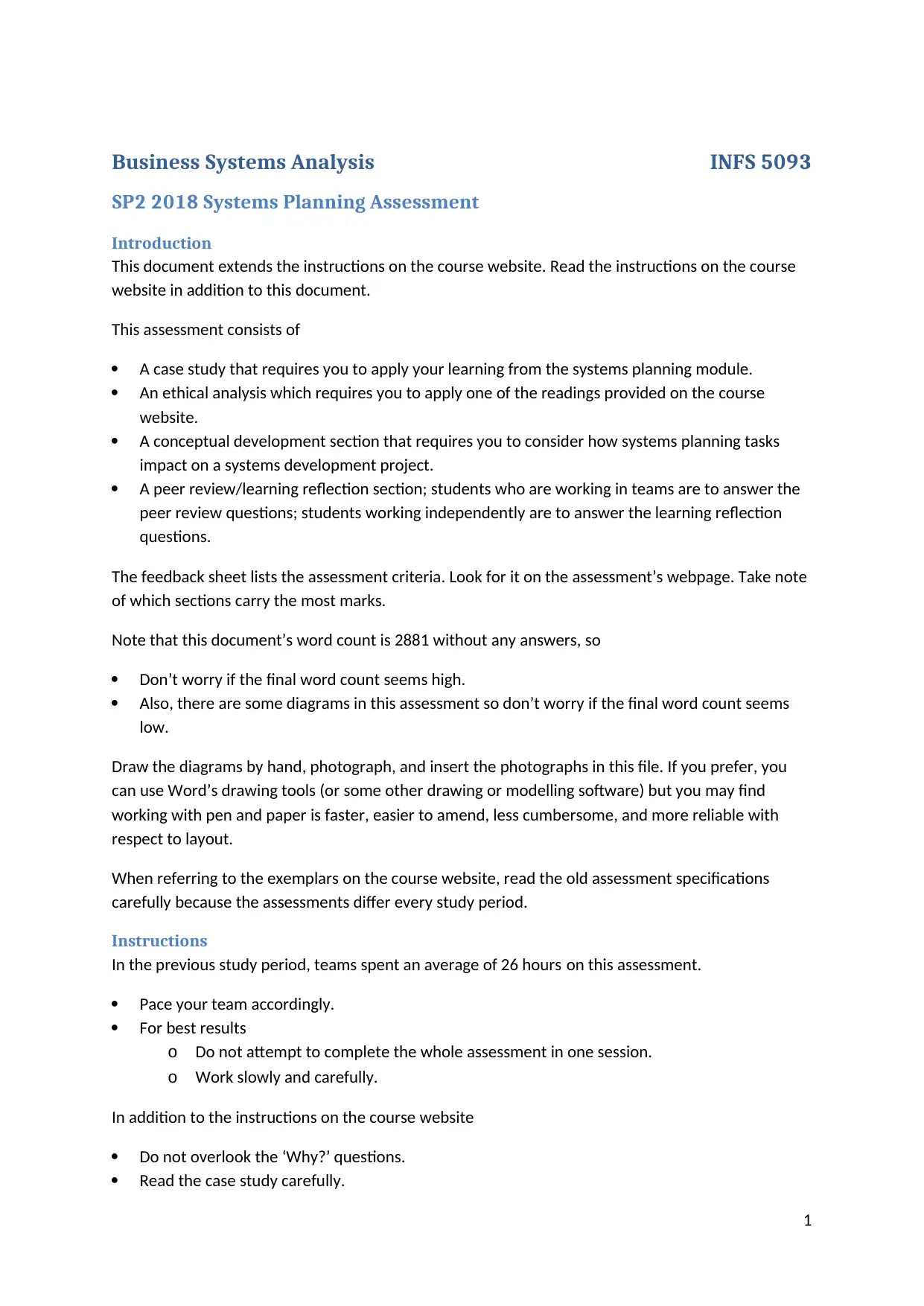
Business Systems Analysis INFS 5093
SP2 2018 Systems Planning Assessment
Introduction
This document extends the instructions on the course website. Read the instructions on the course
website in addition to this document.
This assessment consists of
A case study that requires you to apply your learning from the systems planning module.
An ethical analysis which requires you to apply one of the readings provided on the course
website.
A conceptual development section that requires you to consider how systems planning tasks
impact on a systems development project.
A peer review/learning reflection section; students who are working in teams are to answer the
peer review questions; students working independently are to answer the learning reflection
questions.
The feedback sheet lists the assessment criteria. Look for it on the assessment’s webpage. Take note
of which sections carry the most marks.
Note that this document’s word count is 2881 without any answers, so
Don’t worry if the final word count seems high.
Also, there are some diagrams in this assessment so don’t worry if the final word count seems
low.
Draw the diagrams by hand, photograph, and insert the photographs in this file. If you prefer, you
can use Word’s drawing tools (or some other drawing or modelling software) but you may find
working with pen and paper is faster, easier to amend, less cumbersome, and more reliable with
respect to layout.
When referring to the exemplars on the course website, read the old assessment specifications
carefully because the assessments differ every study period.
Instructions
In the previous study period, teams spent an average of 26 hours on this assessment.
Pace your team accordingly.
For best results
o Do not attempt to complete the whole assessment in one session.
o Work slowly and carefully.
In addition to the instructions on the course website
Do not overlook the ‘Why?’ questions.
Read the case study carefully.
1
SP2 2018 Systems Planning Assessment
Introduction
This document extends the instructions on the course website. Read the instructions on the course
website in addition to this document.
This assessment consists of
A case study that requires you to apply your learning from the systems planning module.
An ethical analysis which requires you to apply one of the readings provided on the course
website.
A conceptual development section that requires you to consider how systems planning tasks
impact on a systems development project.
A peer review/learning reflection section; students who are working in teams are to answer the
peer review questions; students working independently are to answer the learning reflection
questions.
The feedback sheet lists the assessment criteria. Look for it on the assessment’s webpage. Take note
of which sections carry the most marks.
Note that this document’s word count is 2881 without any answers, so
Don’t worry if the final word count seems high.
Also, there are some diagrams in this assessment so don’t worry if the final word count seems
low.
Draw the diagrams by hand, photograph, and insert the photographs in this file. If you prefer, you
can use Word’s drawing tools (or some other drawing or modelling software) but you may find
working with pen and paper is faster, easier to amend, less cumbersome, and more reliable with
respect to layout.
When referring to the exemplars on the course website, read the old assessment specifications
carefully because the assessments differ every study period.
Instructions
In the previous study period, teams spent an average of 26 hours on this assessment.
Pace your team accordingly.
For best results
o Do not attempt to complete the whole assessment in one session.
o Work slowly and carefully.
In addition to the instructions on the course website
Do not overlook the ‘Why?’ questions.
Read the case study carefully.
1
Paraphrase This Document
Need a fresh take? Get an instant paraphrase of this document with our AI Paraphraser
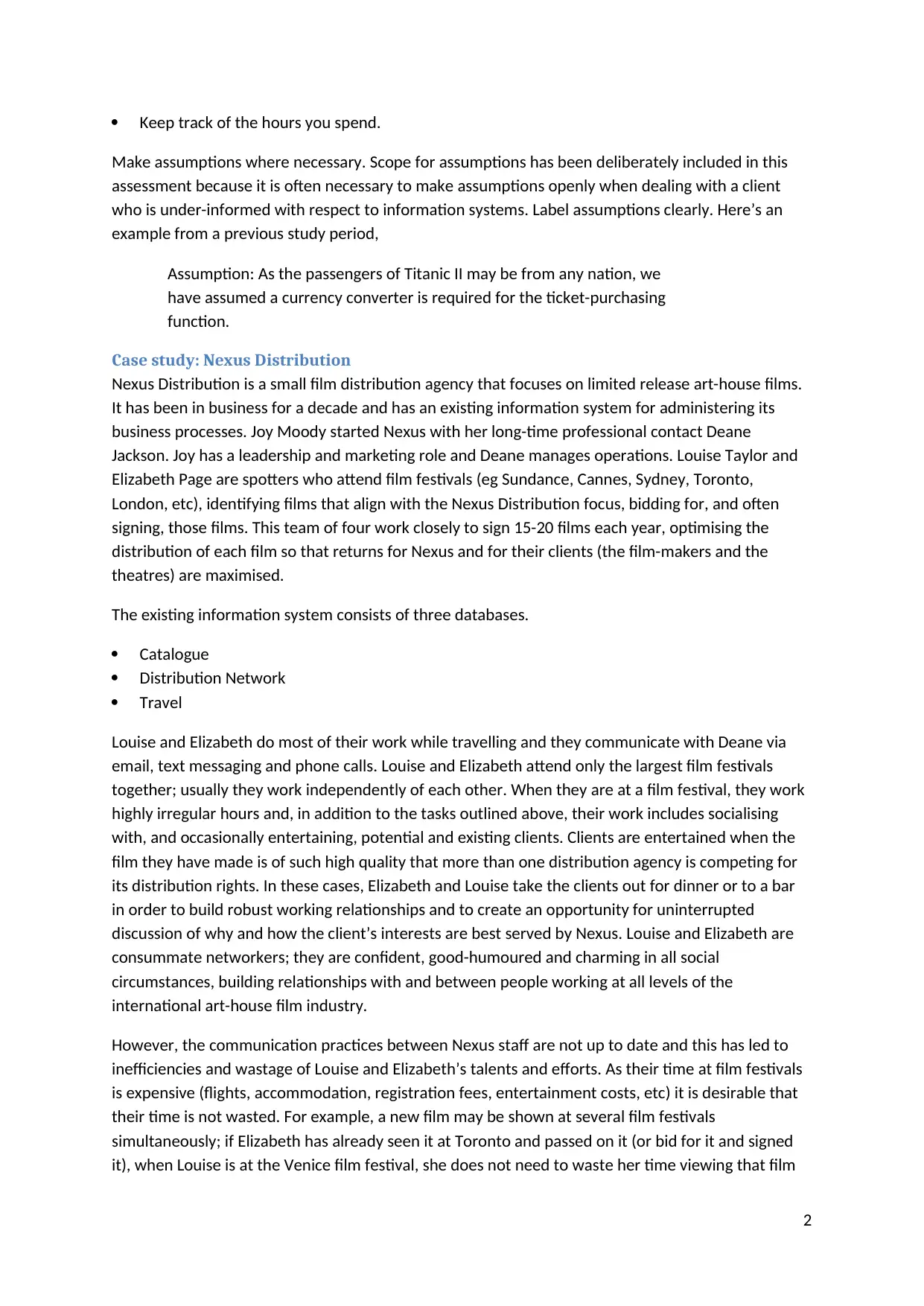
Keep track of the hours you spend.
Make assumptions where necessary. Scope for assumptions has been deliberately included in this
assessment because it is often necessary to make assumptions openly when dealing with a client
who is under-informed with respect to information systems. Label assumptions clearly. Here’s an
example from a previous study period,
Assumption: As the passengers of Titanic II may be from any nation, we
have assumed a currency converter is required for the ticket-purchasing
function.
Case study: Nexus Distribution
Nexus Distribution is a small film distribution agency that focuses on limited release art-house films.
It has been in business for a decade and has an existing information system for administering its
business processes. Joy Moody started Nexus with her long-time professional contact Deane
Jackson. Joy has a leadership and marketing role and Deane manages operations. Louise Taylor and
Elizabeth Page are spotters who attend film festivals (eg Sundance, Cannes, Sydney, Toronto,
London, etc), identifying films that align with the Nexus Distribution focus, bidding for, and often
signing, those films. This team of four work closely to sign 15-20 films each year, optimising the
distribution of each film so that returns for Nexus and for their clients (the film-makers and the
theatres) are maximised.
The existing information system consists of three databases.
Catalogue
Distribution Network
Travel
Louise and Elizabeth do most of their work while travelling and they communicate with Deane via
email, text messaging and phone calls. Louise and Elizabeth attend only the largest film festivals
together; usually they work independently of each other. When they are at a film festival, they work
highly irregular hours and, in addition to the tasks outlined above, their work includes socialising
with, and occasionally entertaining, potential and existing clients. Clients are entertained when the
film they have made is of such high quality that more than one distribution agency is competing for
its distribution rights. In these cases, Elizabeth and Louise take the clients out for dinner or to a bar
in order to build robust working relationships and to create an opportunity for uninterrupted
discussion of why and how the client’s interests are best served by Nexus. Louise and Elizabeth are
consummate networkers; they are confident, good-humoured and charming in all social
circumstances, building relationships with and between people working at all levels of the
international art-house film industry.
However, the communication practices between Nexus staff are not up to date and this has led to
inefficiencies and wastage of Louise and Elizabeth’s talents and efforts. As their time at film festivals
is expensive (flights, accommodation, registration fees, entertainment costs, etc) it is desirable that
their time is not wasted. For example, a new film may be shown at several film festivals
simultaneously; if Elizabeth has already seen it at Toronto and passed on it (or bid for it and signed
it), when Louise is at the Venice film festival, she does not need to waste her time viewing that film
2
Make assumptions where necessary. Scope for assumptions has been deliberately included in this
assessment because it is often necessary to make assumptions openly when dealing with a client
who is under-informed with respect to information systems. Label assumptions clearly. Here’s an
example from a previous study period,
Assumption: As the passengers of Titanic II may be from any nation, we
have assumed a currency converter is required for the ticket-purchasing
function.
Case study: Nexus Distribution
Nexus Distribution is a small film distribution agency that focuses on limited release art-house films.
It has been in business for a decade and has an existing information system for administering its
business processes. Joy Moody started Nexus with her long-time professional contact Deane
Jackson. Joy has a leadership and marketing role and Deane manages operations. Louise Taylor and
Elizabeth Page are spotters who attend film festivals (eg Sundance, Cannes, Sydney, Toronto,
London, etc), identifying films that align with the Nexus Distribution focus, bidding for, and often
signing, those films. This team of four work closely to sign 15-20 films each year, optimising the
distribution of each film so that returns for Nexus and for their clients (the film-makers and the
theatres) are maximised.
The existing information system consists of three databases.
Catalogue
Distribution Network
Travel
Louise and Elizabeth do most of their work while travelling and they communicate with Deane via
email, text messaging and phone calls. Louise and Elizabeth attend only the largest film festivals
together; usually they work independently of each other. When they are at a film festival, they work
highly irregular hours and, in addition to the tasks outlined above, their work includes socialising
with, and occasionally entertaining, potential and existing clients. Clients are entertained when the
film they have made is of such high quality that more than one distribution agency is competing for
its distribution rights. In these cases, Elizabeth and Louise take the clients out for dinner or to a bar
in order to build robust working relationships and to create an opportunity for uninterrupted
discussion of why and how the client’s interests are best served by Nexus. Louise and Elizabeth are
consummate networkers; they are confident, good-humoured and charming in all social
circumstances, building relationships with and between people working at all levels of the
international art-house film industry.
However, the communication practices between Nexus staff are not up to date and this has led to
inefficiencies and wastage of Louise and Elizabeth’s talents and efforts. As their time at film festivals
is expensive (flights, accommodation, registration fees, entertainment costs, etc) it is desirable that
their time is not wasted. For example, a new film may be shown at several film festivals
simultaneously; if Elizabeth has already seen it at Toronto and passed on it (or bid for it and signed
it), when Louise is at the Venice film festival, she does not need to waste her time viewing that film
2
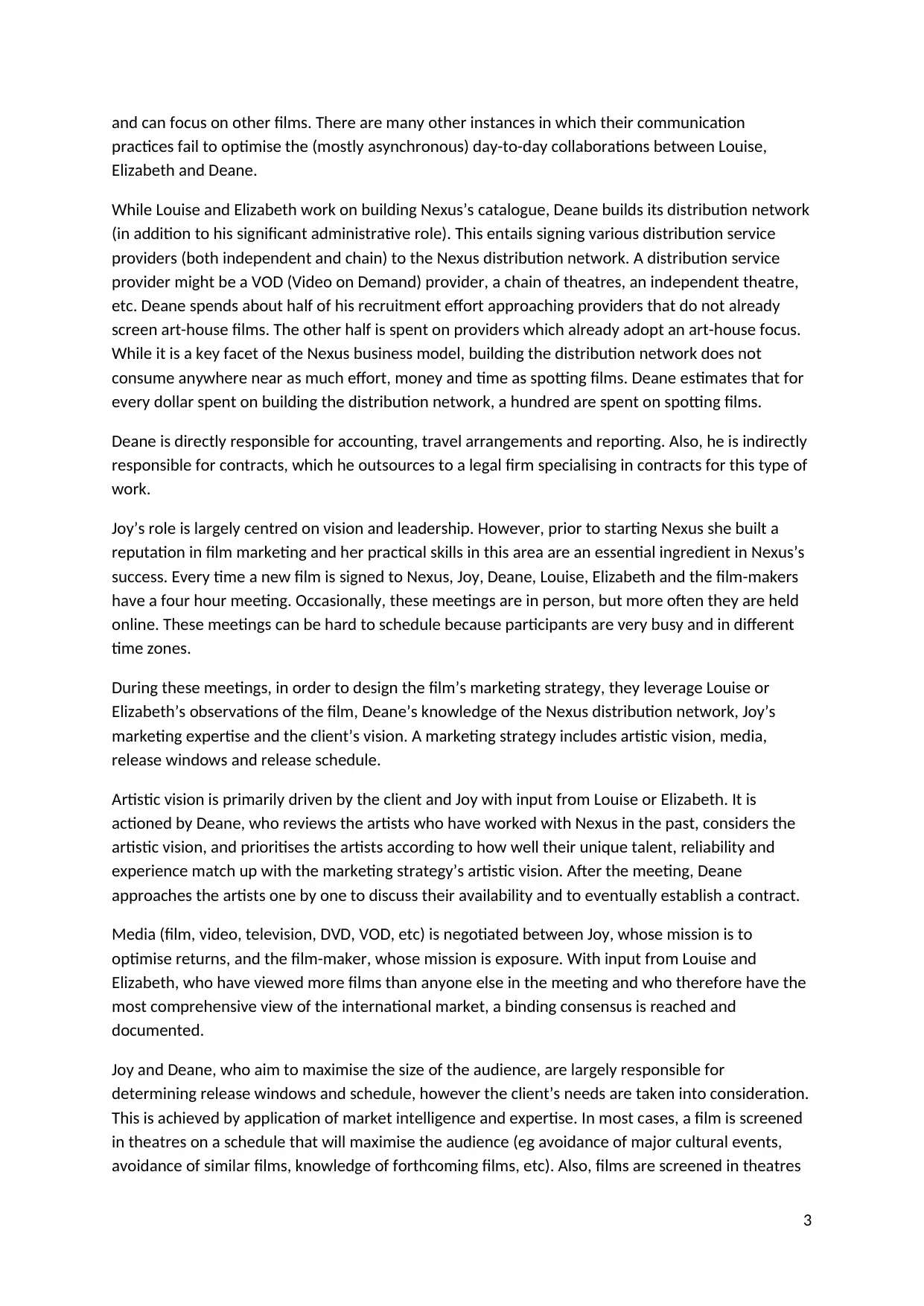
and can focus on other films. There are many other instances in which their communication
practices fail to optimise the (mostly asynchronous) day-to-day collaborations between Louise,
Elizabeth and Deane.
While Louise and Elizabeth work on building Nexus’s catalogue, Deane builds its distribution network
(in addition to his significant administrative role). This entails signing various distribution service
providers (both independent and chain) to the Nexus distribution network. A distribution service
provider might be a VOD (Video on Demand) provider, a chain of theatres, an independent theatre,
etc. Deane spends about half of his recruitment effort approaching providers that do not already
screen art-house films. The other half is spent on providers which already adopt an art-house focus.
While it is a key facet of the Nexus business model, building the distribution network does not
consume anywhere near as much effort, money and time as spotting films. Deane estimates that for
every dollar spent on building the distribution network, a hundred are spent on spotting films.
Deane is directly responsible for accounting, travel arrangements and reporting. Also, he is indirectly
responsible for contracts, which he outsources to a legal firm specialising in contracts for this type of
work.
Joy’s role is largely centred on vision and leadership. However, prior to starting Nexus she built a
reputation in film marketing and her practical skills in this area are an essential ingredient in Nexus’s
success. Every time a new film is signed to Nexus, Joy, Deane, Louise, Elizabeth and the film-makers
have a four hour meeting. Occasionally, these meetings are in person, but more often they are held
online. These meetings can be hard to schedule because participants are very busy and in different
time zones.
During these meetings, in order to design the film’s marketing strategy, they leverage Louise or
Elizabeth’s observations of the film, Deane’s knowledge of the Nexus distribution network, Joy’s
marketing expertise and the client’s vision. A marketing strategy includes artistic vision, media,
release windows and release schedule.
Artistic vision is primarily driven by the client and Joy with input from Louise or Elizabeth. It is
actioned by Deane, who reviews the artists who have worked with Nexus in the past, considers the
artistic vision, and prioritises the artists according to how well their unique talent, reliability and
experience match up with the marketing strategy’s artistic vision. After the meeting, Deane
approaches the artists one by one to discuss their availability and to eventually establish a contract.
Media (film, video, television, DVD, VOD, etc) is negotiated between Joy, whose mission is to
optimise returns, and the film-maker, whose mission is exposure. With input from Louise and
Elizabeth, who have viewed more films than anyone else in the meeting and who therefore have the
most comprehensive view of the international market, a binding consensus is reached and
documented.
Joy and Deane, who aim to maximise the size of the audience, are largely responsible for
determining release windows and schedule, however the client’s needs are taken into consideration.
This is achieved by application of market intelligence and expertise. In most cases, a film is screened
in theatres on a schedule that will maximise the audience (eg avoidance of major cultural events,
avoidance of similar films, knowledge of forthcoming films, etc). Also, films are screened in theatres
3
practices fail to optimise the (mostly asynchronous) day-to-day collaborations between Louise,
Elizabeth and Deane.
While Louise and Elizabeth work on building Nexus’s catalogue, Deane builds its distribution network
(in addition to his significant administrative role). This entails signing various distribution service
providers (both independent and chain) to the Nexus distribution network. A distribution service
provider might be a VOD (Video on Demand) provider, a chain of theatres, an independent theatre,
etc. Deane spends about half of his recruitment effort approaching providers that do not already
screen art-house films. The other half is spent on providers which already adopt an art-house focus.
While it is a key facet of the Nexus business model, building the distribution network does not
consume anywhere near as much effort, money and time as spotting films. Deane estimates that for
every dollar spent on building the distribution network, a hundred are spent on spotting films.
Deane is directly responsible for accounting, travel arrangements and reporting. Also, he is indirectly
responsible for contracts, which he outsources to a legal firm specialising in contracts for this type of
work.
Joy’s role is largely centred on vision and leadership. However, prior to starting Nexus she built a
reputation in film marketing and her practical skills in this area are an essential ingredient in Nexus’s
success. Every time a new film is signed to Nexus, Joy, Deane, Louise, Elizabeth and the film-makers
have a four hour meeting. Occasionally, these meetings are in person, but more often they are held
online. These meetings can be hard to schedule because participants are very busy and in different
time zones.
During these meetings, in order to design the film’s marketing strategy, they leverage Louise or
Elizabeth’s observations of the film, Deane’s knowledge of the Nexus distribution network, Joy’s
marketing expertise and the client’s vision. A marketing strategy includes artistic vision, media,
release windows and release schedule.
Artistic vision is primarily driven by the client and Joy with input from Louise or Elizabeth. It is
actioned by Deane, who reviews the artists who have worked with Nexus in the past, considers the
artistic vision, and prioritises the artists according to how well their unique talent, reliability and
experience match up with the marketing strategy’s artistic vision. After the meeting, Deane
approaches the artists one by one to discuss their availability and to eventually establish a contract.
Media (film, video, television, DVD, VOD, etc) is negotiated between Joy, whose mission is to
optimise returns, and the film-maker, whose mission is exposure. With input from Louise and
Elizabeth, who have viewed more films than anyone else in the meeting and who therefore have the
most comprehensive view of the international market, a binding consensus is reached and
documented.
Joy and Deane, who aim to maximise the size of the audience, are largely responsible for
determining release windows and schedule, however the client’s needs are taken into consideration.
This is achieved by application of market intelligence and expertise. In most cases, a film is screened
in theatres on a schedule that will maximise the audience (eg avoidance of major cultural events,
avoidance of similar films, knowledge of forthcoming films, etc). Also, films are screened in theatres
3
⊘ This is a preview!⊘
Do you want full access?
Subscribe today to unlock all pages.

Trusted by 1+ million students worldwide

(primary distribution service providers) prior to being released via secondary distribution service
providers (eg VOD service providers, DVD runs, etc). The duration for which the film is screened in
theatres depends upon various factors (audience, the film’s performance in other markets, the
agreement between Nexus and the film-makers, the agreement between Nexus and the theatres,
etc). For most films, the theatrical release date is preceded by four weeks of postering and trailers,
wherever possible working with the film-makers in order to leverage the social profiles of those who
worked on the film (eg the actors and crew). For highly anticipated films, these four weeks may
extend to six or eight and may require Deane to schedule interviews for the film-makers or actors
with local media.
Although the existing IS meets Nexus’s administrative needs, the ongoing daily communication
problems and the difficulties of scheduling and running online meetings need to be addressed.
Deane thinks Nexus needs its own app so that database updates can be done by anyone at any time
and he has contacted your workplace, IT Foundry, to enquire further. You have been allocated the
task of systems planning for the development of an app for Nexus.
Also, although they are very talented, experienced and respected in their fields, the entire Nexus
team are inexperienced in systems analysis and design. They are confident you will come up with
relevant ideas, they anticipate your suggestions and they expect you to catalyse and drive all
technical aspects of the project. These clients are very much open to suggestion.
As you have never worked in this field before, you begin by reading about film distribution on
Wikipedia. Then, you move forward with systems planning.
Recall: you can make assumptions in this assignment (as noted in the instructions above). Also, you
can use the course forum if you have any questions.
1. Develop a business profile for Nexus Distribution. The profile must include mission, functions,
how the organisation is organised, products, services and customers.
Mission – The mission of Nexus Distribution is to capture more part of the film distribution
market by distributing high quality art films and also promote newcomer artists and film makers
by publicizing their movies.
Functions – The function of Nexus is to meet new film makers and artists at large film festivals
and gain distribution rights for the new art films.
The company is generally well organized with experienced and well mannered staff and
management team members. Nexus deals with the distribution of new art films in various media
and always ensures business with high profile clients that produce good quality films with good
marketing prospect. There is a good customer base for the company who watch the films in
various media like cinema hall, video on demand and others. However, in terms of information
system, the company has not been able to update itself till now.
2. List four of Nexus’s business processes. Aim to identify business processes that are related to the
proposed Nexus app.
Four business processes of Nexus are listed as follows.
4
providers (eg VOD service providers, DVD runs, etc). The duration for which the film is screened in
theatres depends upon various factors (audience, the film’s performance in other markets, the
agreement between Nexus and the film-makers, the agreement between Nexus and the theatres,
etc). For most films, the theatrical release date is preceded by four weeks of postering and trailers,
wherever possible working with the film-makers in order to leverage the social profiles of those who
worked on the film (eg the actors and crew). For highly anticipated films, these four weeks may
extend to six or eight and may require Deane to schedule interviews for the film-makers or actors
with local media.
Although the existing IS meets Nexus’s administrative needs, the ongoing daily communication
problems and the difficulties of scheduling and running online meetings need to be addressed.
Deane thinks Nexus needs its own app so that database updates can be done by anyone at any time
and he has contacted your workplace, IT Foundry, to enquire further. You have been allocated the
task of systems planning for the development of an app for Nexus.
Also, although they are very talented, experienced and respected in their fields, the entire Nexus
team are inexperienced in systems analysis and design. They are confident you will come up with
relevant ideas, they anticipate your suggestions and they expect you to catalyse and drive all
technical aspects of the project. These clients are very much open to suggestion.
As you have never worked in this field before, you begin by reading about film distribution on
Wikipedia. Then, you move forward with systems planning.
Recall: you can make assumptions in this assignment (as noted in the instructions above). Also, you
can use the course forum if you have any questions.
1. Develop a business profile for Nexus Distribution. The profile must include mission, functions,
how the organisation is organised, products, services and customers.
Mission – The mission of Nexus Distribution is to capture more part of the film distribution
market by distributing high quality art films and also promote newcomer artists and film makers
by publicizing their movies.
Functions – The function of Nexus is to meet new film makers and artists at large film festivals
and gain distribution rights for the new art films.
The company is generally well organized with experienced and well mannered staff and
management team members. Nexus deals with the distribution of new art films in various media
and always ensures business with high profile clients that produce good quality films with good
marketing prospect. There is a good customer base for the company who watch the films in
various media like cinema hall, video on demand and others. However, in terms of information
system, the company has not been able to update itself till now.
2. List four of Nexus’s business processes. Aim to identify business processes that are related to the
proposed Nexus app.
Four business processes of Nexus are listed as follows.
4
Paraphrase This Document
Need a fresh take? Get an instant paraphrase of this document with our AI Paraphraser
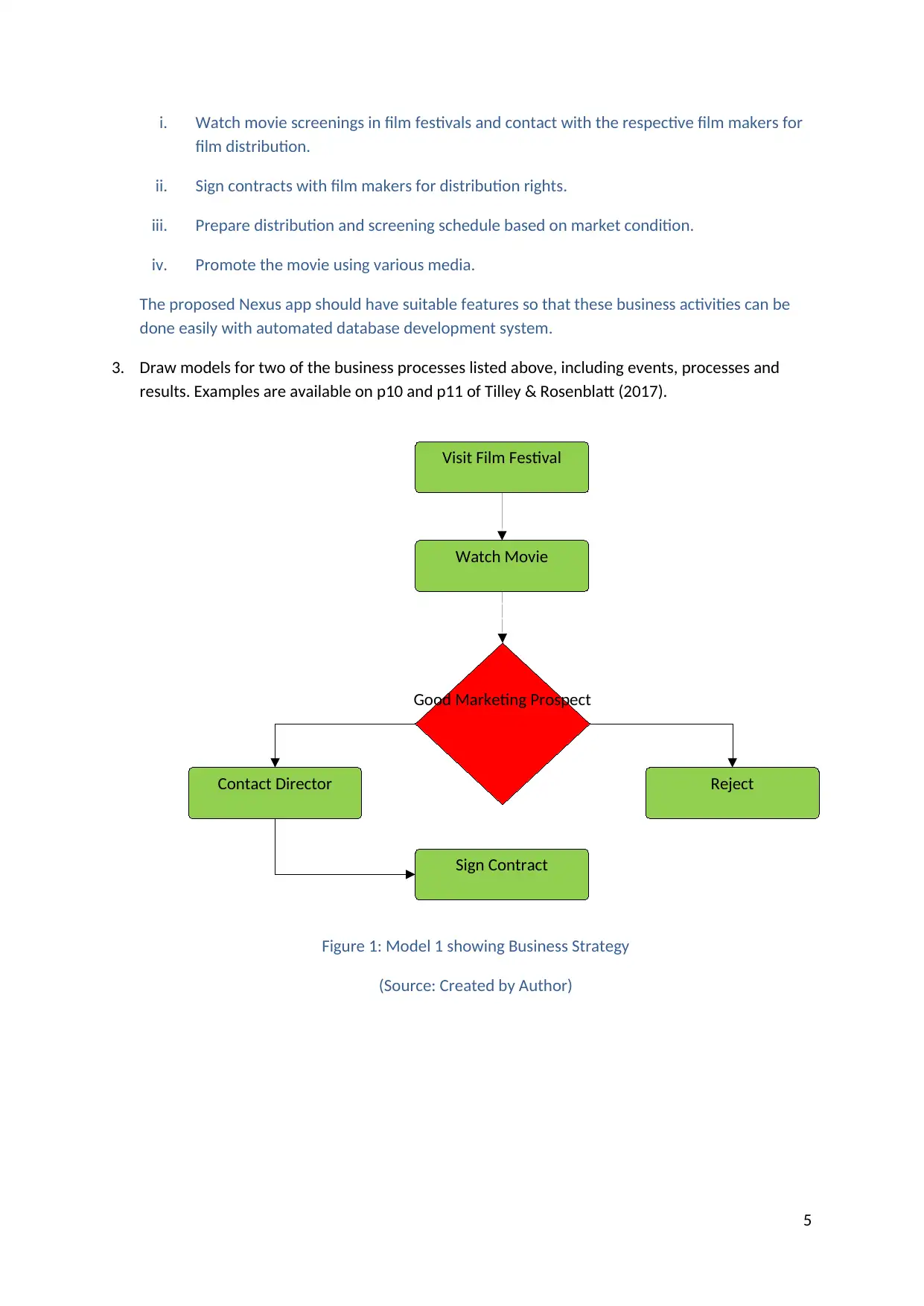
Visit Film Festival
RejectContact Director
Sign Contract
Good Marketing Prospect
Watch Movie
i. Watch movie screenings in film festivals and contact with the respective film makers for
film distribution.
ii. Sign contracts with film makers for distribution rights.
iii. Prepare distribution and screening schedule based on market condition.
iv. Promote the movie using various media.
The proposed Nexus app should have suitable features so that these business activities can be
done easily with automated database development system.
3. Draw models for two of the business processes listed above, including events, processes and
results. Examples are available on p10 and p11 of Tilley & Rosenblatt (2017).
Figure 1: Model 1 showing Business Strategy
(Source: Created by Author)
5
RejectContact Director
Sign Contract
Good Marketing Prospect
Watch Movie
i. Watch movie screenings in film festivals and contact with the respective film makers for
film distribution.
ii. Sign contracts with film makers for distribution rights.
iii. Prepare distribution and screening schedule based on market condition.
iv. Promote the movie using various media.
The proposed Nexus app should have suitable features so that these business activities can be
done easily with automated database development system.
3. Draw models for two of the business processes listed above, including events, processes and
results. Examples are available on p10 and p11 of Tilley & Rosenblatt (2017).
Figure 1: Model 1 showing Business Strategy
(Source: Created by Author)
5
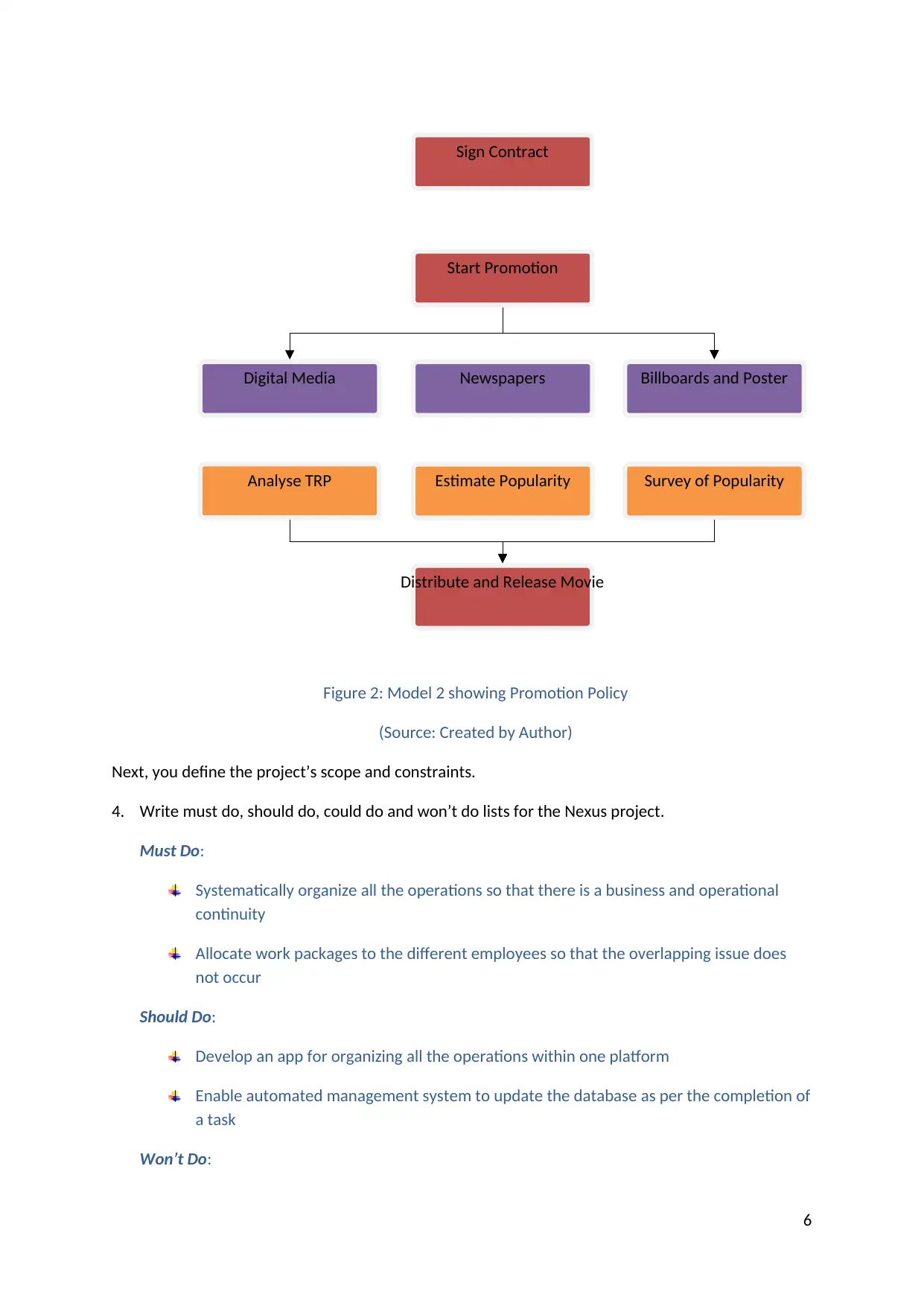
Sign Contract
Digital Media
Start Promotion
Newspapers Billboards and Poster
Analyse TRP Estimate Popularity Survey of Popularity
Distribute and Release Movie
Figure 2: Model 2 showing Promotion Policy
(Source: Created by Author)
Next, you define the project’s scope and constraints.
4. Write must do, should do, could do and won’t do lists for the Nexus project.
Must Do:
Systematically organize all the operations so that there is a business and operational
continuity
Allocate work packages to the different employees so that the overlapping issue does
not occur
Should Do:
Develop an app for organizing all the operations within one platform
Enable automated management system to update the database as per the completion of
a task
Won’t Do:
6
Digital Media
Start Promotion
Newspapers Billboards and Poster
Analyse TRP Estimate Popularity Survey of Popularity
Distribute and Release Movie
Figure 2: Model 2 showing Promotion Policy
(Source: Created by Author)
Next, you define the project’s scope and constraints.
4. Write must do, should do, could do and won’t do lists for the Nexus project.
Must Do:
Systematically organize all the operations so that there is a business and operational
continuity
Allocate work packages to the different employees so that the overlapping issue does
not occur
Should Do:
Develop an app for organizing all the operations within one platform
Enable automated management system to update the database as per the completion of
a task
Won’t Do:
6
⊘ This is a preview!⊘
Do you want full access?
Subscribe today to unlock all pages.

Trusted by 1+ million students worldwide

Rush to recruit for more technically adept employees
Heavily invest in complete overhaul of IT system
5. Write a scope statement for the Nexus project.
† Development of a new app for organizing all business operations is within the scope of
the project.
† Development of an automated system for updating database is within the scope of the
project.
6. Prepare a constraints map for the Nexus project. There is an example of a constraints map on
p60 of Tilley & Rosenblatt (2017).
Level of
Constraint
Control and
Mitigation
Project Activities
Low Impact Film
Makers
Rising Film
Makers
Reputed Film
Makers
No Go Marketing
Techniques
Yes No No
High Marketing
Techniques
Yes Yes No
Moderate Marketing
Techniques
Yes Yes Yes
Low Marketing
Techniques
Yes Yes Yes
You prepare for fact-finding.
7. What approaches to fact-finding will you adopt for the Nexus project? Why?
The method of fact finding to be adopted in the Nexus project is services analysis. In this
approach, the aspects of service of Nexus to be analysed are:
Number of film makers who are under contract with Nexus
Number of films that Nexus distribute every year
Average number of audiences per film release
Average revenue and profit per film
Market analysis
The next step is to evaluate the project’s feasibility.
8. List four questions that will enable you to investigate the feasibility of the Nexus project.
The four questions are as follows.
Can the app be developed within the budget limitation of the project?
7
Heavily invest in complete overhaul of IT system
5. Write a scope statement for the Nexus project.
† Development of a new app for organizing all business operations is within the scope of
the project.
† Development of an automated system for updating database is within the scope of the
project.
6. Prepare a constraints map for the Nexus project. There is an example of a constraints map on
p60 of Tilley & Rosenblatt (2017).
Level of
Constraint
Control and
Mitigation
Project Activities
Low Impact Film
Makers
Rising Film
Makers
Reputed Film
Makers
No Go Marketing
Techniques
Yes No No
High Marketing
Techniques
Yes Yes No
Moderate Marketing
Techniques
Yes Yes Yes
Low Marketing
Techniques
Yes Yes Yes
You prepare for fact-finding.
7. What approaches to fact-finding will you adopt for the Nexus project? Why?
The method of fact finding to be adopted in the Nexus project is services analysis. In this
approach, the aspects of service of Nexus to be analysed are:
Number of film makers who are under contract with Nexus
Number of films that Nexus distribute every year
Average number of audiences per film release
Average revenue and profit per film
Market analysis
The next step is to evaluate the project’s feasibility.
8. List four questions that will enable you to investigate the feasibility of the Nexus project.
The four questions are as follows.
Can the app be developed within the budget limitation of the project?
7
Paraphrase This Document
Need a fresh take? Get an instant paraphrase of this document with our AI Paraphraser
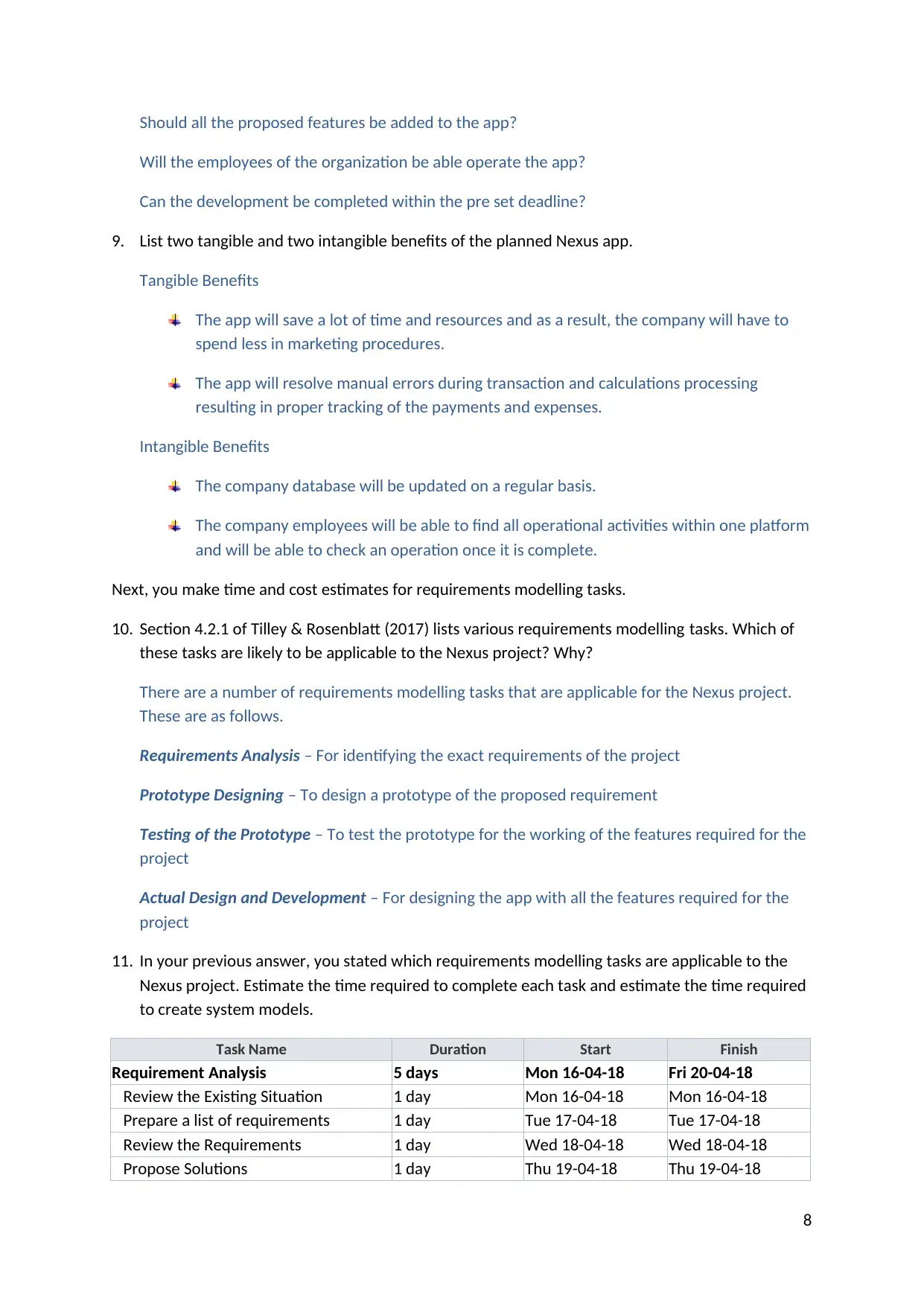
Should all the proposed features be added to the app?
Will the employees of the organization be able operate the app?
Can the development be completed within the pre set deadline?
9. List two tangible and two intangible benefits of the planned Nexus app.
Tangible Benefits
The app will save a lot of time and resources and as a result, the company will have to
spend less in marketing procedures.
The app will resolve manual errors during transaction and calculations processing
resulting in proper tracking of the payments and expenses.
Intangible Benefits
The company database will be updated on a regular basis.
The company employees will be able to find all operational activities within one platform
and will be able to check an operation once it is complete.
Next, you make time and cost estimates for requirements modelling tasks.
10. Section 4.2.1 of Tilley & Rosenblatt (2017) lists various requirements modelling tasks. Which of
these tasks are likely to be applicable to the Nexus project? Why?
There are a number of requirements modelling tasks that are applicable for the Nexus project.
These are as follows.
Requirements Analysis – For identifying the exact requirements of the project
Prototype Designing – To design a prototype of the proposed requirement
Testing of the Prototype – To test the prototype for the working of the features required for the
project
Actual Design and Development – For designing the app with all the features required for the
project
11. In your previous answer, you stated which requirements modelling tasks are applicable to the
Nexus project. Estimate the time required to complete each task and estimate the time required
to create system models.
Task Name Duration Start Finish
Requirement Analysis 5 days Mon 16-04-18 Fri 20-04-18
Review the Existing Situation 1 day Mon 16-04-18 Mon 16-04-18
Prepare a list of requirements 1 day Tue 17-04-18 Tue 17-04-18
Review the Requirements 1 day Wed 18-04-18 Wed 18-04-18
Propose Solutions 1 day Thu 19-04-18 Thu 19-04-18
8
Will the employees of the organization be able operate the app?
Can the development be completed within the pre set deadline?
9. List two tangible and two intangible benefits of the planned Nexus app.
Tangible Benefits
The app will save a lot of time and resources and as a result, the company will have to
spend less in marketing procedures.
The app will resolve manual errors during transaction and calculations processing
resulting in proper tracking of the payments and expenses.
Intangible Benefits
The company database will be updated on a regular basis.
The company employees will be able to find all operational activities within one platform
and will be able to check an operation once it is complete.
Next, you make time and cost estimates for requirements modelling tasks.
10. Section 4.2.1 of Tilley & Rosenblatt (2017) lists various requirements modelling tasks. Which of
these tasks are likely to be applicable to the Nexus project? Why?
There are a number of requirements modelling tasks that are applicable for the Nexus project.
These are as follows.
Requirements Analysis – For identifying the exact requirements of the project
Prototype Designing – To design a prototype of the proposed requirement
Testing of the Prototype – To test the prototype for the working of the features required for the
project
Actual Design and Development – For designing the app with all the features required for the
project
11. In your previous answer, you stated which requirements modelling tasks are applicable to the
Nexus project. Estimate the time required to complete each task and estimate the time required
to create system models.
Task Name Duration Start Finish
Requirement Analysis 5 days Mon 16-04-18 Fri 20-04-18
Review the Existing Situation 1 day Mon 16-04-18 Mon 16-04-18
Prepare a list of requirements 1 day Tue 17-04-18 Tue 17-04-18
Review the Requirements 1 day Wed 18-04-18 Wed 18-04-18
Propose Solutions 1 day Thu 19-04-18 Thu 19-04-18
8
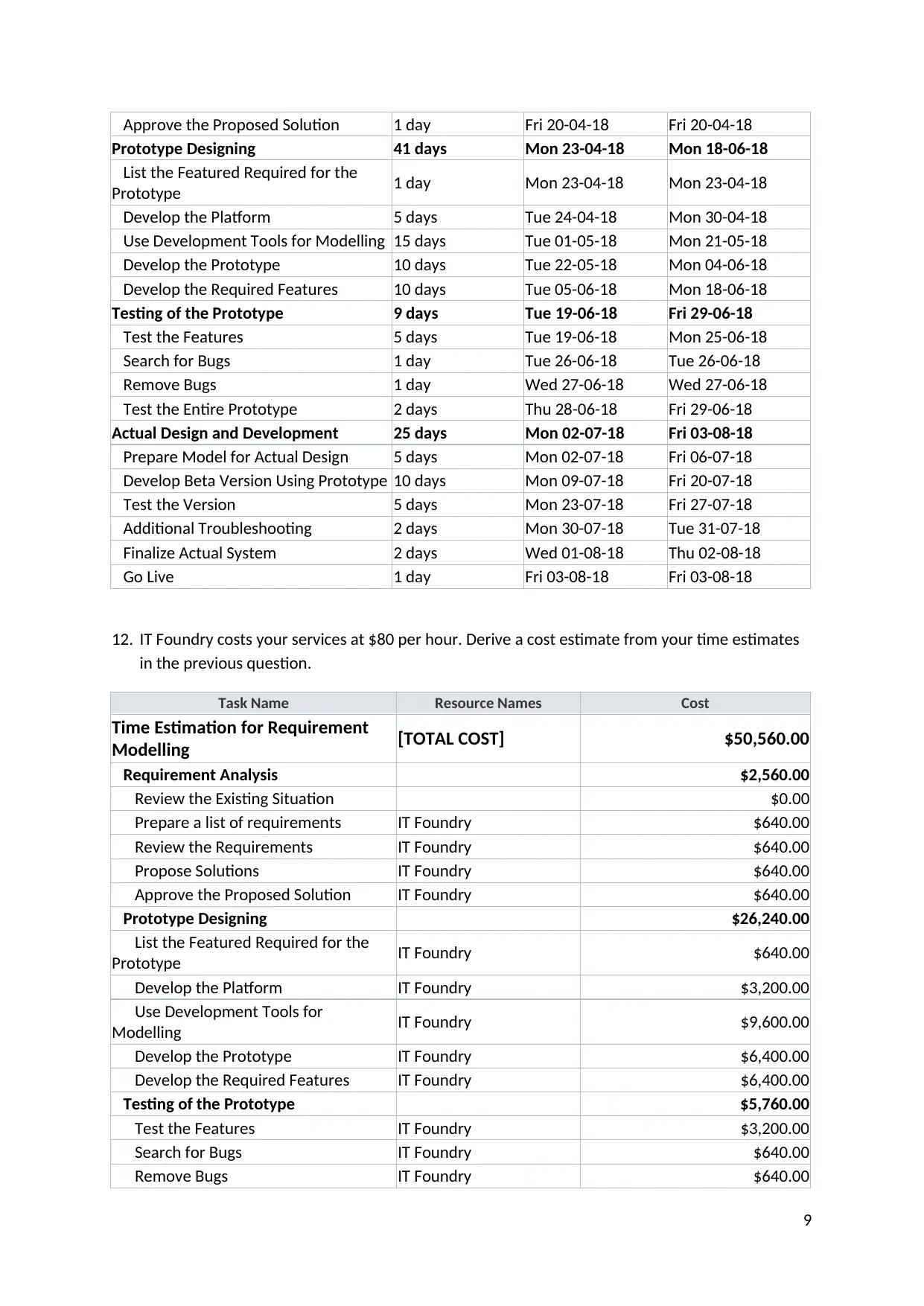
Approve the Proposed Solution 1 day Fri 20-04-18 Fri 20-04-18
Prototype Designing 41 days Mon 23-04-18 Mon 18-06-18
List the Featured Required for the
Prototype 1 day Mon 23-04-18 Mon 23-04-18
Develop the Platform 5 days Tue 24-04-18 Mon 30-04-18
Use Development Tools for Modelling 15 days Tue 01-05-18 Mon 21-05-18
Develop the Prototype 10 days Tue 22-05-18 Mon 04-06-18
Develop the Required Features 10 days Tue 05-06-18 Mon 18-06-18
Testing of the Prototype 9 days Tue 19-06-18 Fri 29-06-18
Test the Features 5 days Tue 19-06-18 Mon 25-06-18
Search for Bugs 1 day Tue 26-06-18 Tue 26-06-18
Remove Bugs 1 day Wed 27-06-18 Wed 27-06-18
Test the Entire Prototype 2 days Thu 28-06-18 Fri 29-06-18
Actual Design and Development 25 days Mon 02-07-18 Fri 03-08-18
Prepare Model for Actual Design 5 days Mon 02-07-18 Fri 06-07-18
Develop Beta Version Using Prototype 10 days Mon 09-07-18 Fri 20-07-18
Test the Version 5 days Mon 23-07-18 Fri 27-07-18
Additional Troubleshooting 2 days Mon 30-07-18 Tue 31-07-18
Finalize Actual System 2 days Wed 01-08-18 Thu 02-08-18
Go Live 1 day Fri 03-08-18 Fri 03-08-18
12. IT Foundry costs your services at $80 per hour. Derive a cost estimate from your time estimates
in the previous question.
Task Name Resource Names Cost
Time Estimation for Requirement
Modelling [TOTAL COST] $50,560.00
Requirement Analysis $2,560.00
Review the Existing Situation $0.00
Prepare a list of requirements IT Foundry $640.00
Review the Requirements IT Foundry $640.00
Propose Solutions IT Foundry $640.00
Approve the Proposed Solution IT Foundry $640.00
Prototype Designing $26,240.00
List the Featured Required for the
Prototype IT Foundry $640.00
Develop the Platform IT Foundry $3,200.00
Use Development Tools for
Modelling IT Foundry $9,600.00
Develop the Prototype IT Foundry $6,400.00
Develop the Required Features IT Foundry $6,400.00
Testing of the Prototype $5,760.00
Test the Features IT Foundry $3,200.00
Search for Bugs IT Foundry $640.00
Remove Bugs IT Foundry $640.00
9
Prototype Designing 41 days Mon 23-04-18 Mon 18-06-18
List the Featured Required for the
Prototype 1 day Mon 23-04-18 Mon 23-04-18
Develop the Platform 5 days Tue 24-04-18 Mon 30-04-18
Use Development Tools for Modelling 15 days Tue 01-05-18 Mon 21-05-18
Develop the Prototype 10 days Tue 22-05-18 Mon 04-06-18
Develop the Required Features 10 days Tue 05-06-18 Mon 18-06-18
Testing of the Prototype 9 days Tue 19-06-18 Fri 29-06-18
Test the Features 5 days Tue 19-06-18 Mon 25-06-18
Search for Bugs 1 day Tue 26-06-18 Tue 26-06-18
Remove Bugs 1 day Wed 27-06-18 Wed 27-06-18
Test the Entire Prototype 2 days Thu 28-06-18 Fri 29-06-18
Actual Design and Development 25 days Mon 02-07-18 Fri 03-08-18
Prepare Model for Actual Design 5 days Mon 02-07-18 Fri 06-07-18
Develop Beta Version Using Prototype 10 days Mon 09-07-18 Fri 20-07-18
Test the Version 5 days Mon 23-07-18 Fri 27-07-18
Additional Troubleshooting 2 days Mon 30-07-18 Tue 31-07-18
Finalize Actual System 2 days Wed 01-08-18 Thu 02-08-18
Go Live 1 day Fri 03-08-18 Fri 03-08-18
12. IT Foundry costs your services at $80 per hour. Derive a cost estimate from your time estimates
in the previous question.
Task Name Resource Names Cost
Time Estimation for Requirement
Modelling [TOTAL COST] $50,560.00
Requirement Analysis $2,560.00
Review the Existing Situation $0.00
Prepare a list of requirements IT Foundry $640.00
Review the Requirements IT Foundry $640.00
Propose Solutions IT Foundry $640.00
Approve the Proposed Solution IT Foundry $640.00
Prototype Designing $26,240.00
List the Featured Required for the
Prototype IT Foundry $640.00
Develop the Platform IT Foundry $3,200.00
Use Development Tools for
Modelling IT Foundry $9,600.00
Develop the Prototype IT Foundry $6,400.00
Develop the Required Features IT Foundry $6,400.00
Testing of the Prototype $5,760.00
Test the Features IT Foundry $3,200.00
Search for Bugs IT Foundry $640.00
Remove Bugs IT Foundry $640.00
9
⊘ This is a preview!⊘
Do you want full access?
Subscribe today to unlock all pages.

Trusted by 1+ million students worldwide
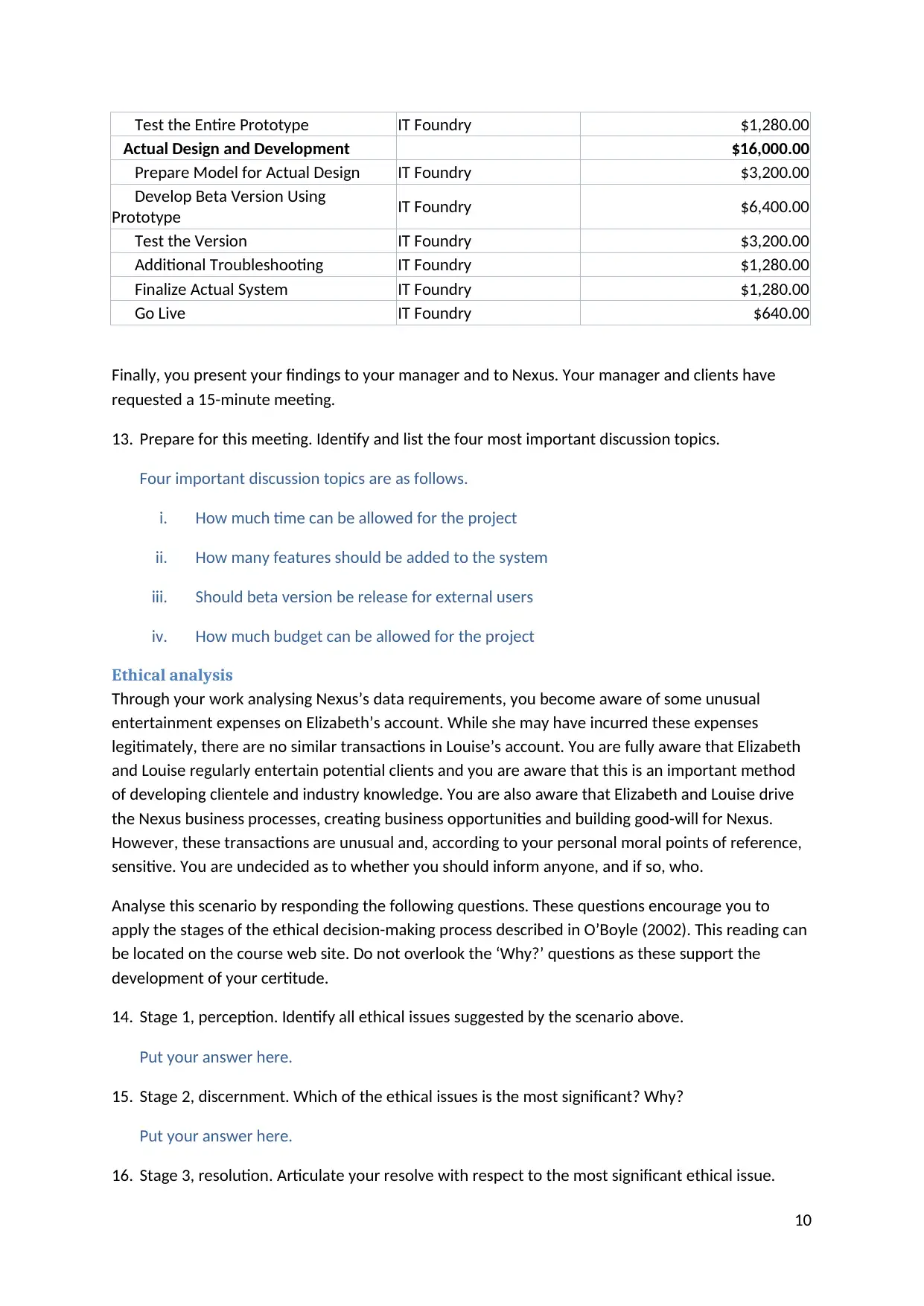
Test the Entire Prototype IT Foundry $1,280.00
Actual Design and Development $16,000.00
Prepare Model for Actual Design IT Foundry $3,200.00
Develop Beta Version Using
Prototype IT Foundry $6,400.00
Test the Version IT Foundry $3,200.00
Additional Troubleshooting IT Foundry $1,280.00
Finalize Actual System IT Foundry $1,280.00
Go Live IT Foundry $640.00
Finally, you present your findings to your manager and to Nexus. Your manager and clients have
requested a 15-minute meeting.
13. Prepare for this meeting. Identify and list the four most important discussion topics.
Four important discussion topics are as follows.
i. How much time can be allowed for the project
ii. How many features should be added to the system
iii. Should beta version be release for external users
iv. How much budget can be allowed for the project
Ethical analysis
Through your work analysing Nexus’s data requirements, you become aware of some unusual
entertainment expenses on Elizabeth’s account. While she may have incurred these expenses
legitimately, there are no similar transactions in Louise’s account. You are fully aware that Elizabeth
and Louise regularly entertain potential clients and you are aware that this is an important method
of developing clientele and industry knowledge. You are also aware that Elizabeth and Louise drive
the Nexus business processes, creating business opportunities and building good-will for Nexus.
However, these transactions are unusual and, according to your personal moral points of reference,
sensitive. You are undecided as to whether you should inform anyone, and if so, who.
Analyse this scenario by responding the following questions. These questions encourage you to
apply the stages of the ethical decision-making process described in O’Boyle (2002). This reading can
be located on the course web site. Do not overlook the ‘Why?’ questions as these support the
development of your certitude.
14. Stage 1, perception. Identify all ethical issues suggested by the scenario above.
Put your answer here.
15. Stage 2, discernment. Which of the ethical issues is the most significant? Why?
Put your answer here.
16. Stage 3, resolution. Articulate your resolve with respect to the most significant ethical issue.
10
Actual Design and Development $16,000.00
Prepare Model for Actual Design IT Foundry $3,200.00
Develop Beta Version Using
Prototype IT Foundry $6,400.00
Test the Version IT Foundry $3,200.00
Additional Troubleshooting IT Foundry $1,280.00
Finalize Actual System IT Foundry $1,280.00
Go Live IT Foundry $640.00
Finally, you present your findings to your manager and to Nexus. Your manager and clients have
requested a 15-minute meeting.
13. Prepare for this meeting. Identify and list the four most important discussion topics.
Four important discussion topics are as follows.
i. How much time can be allowed for the project
ii. How many features should be added to the system
iii. Should beta version be release for external users
iv. How much budget can be allowed for the project
Ethical analysis
Through your work analysing Nexus’s data requirements, you become aware of some unusual
entertainment expenses on Elizabeth’s account. While she may have incurred these expenses
legitimately, there are no similar transactions in Louise’s account. You are fully aware that Elizabeth
and Louise regularly entertain potential clients and you are aware that this is an important method
of developing clientele and industry knowledge. You are also aware that Elizabeth and Louise drive
the Nexus business processes, creating business opportunities and building good-will for Nexus.
However, these transactions are unusual and, according to your personal moral points of reference,
sensitive. You are undecided as to whether you should inform anyone, and if so, who.
Analyse this scenario by responding the following questions. These questions encourage you to
apply the stages of the ethical decision-making process described in O’Boyle (2002). This reading can
be located on the course web site. Do not overlook the ‘Why?’ questions as these support the
development of your certitude.
14. Stage 1, perception. Identify all ethical issues suggested by the scenario above.
Put your answer here.
15. Stage 2, discernment. Which of the ethical issues is the most significant? Why?
Put your answer here.
16. Stage 3, resolution. Articulate your resolve with respect to the most significant ethical issue.
10
Paraphrase This Document
Need a fresh take? Get an instant paraphrase of this document with our AI Paraphraser

Put your answer here.
17. Stage 4, assessment. Are you qualified to act in accordance with your resolve or do you need to
seek the advice of an independent expert? Why?
Put your answer here.
18. Stage 5, decision. What are your professional duties in this situation? Why?
Put your answer here.
19. Stage 6, action. Have stages 1-5 enabled you to form a commitment to action? Why?
Put your answer here.
Conceptual development and risk identification
Consider the Nexus case study and the systems planning you have completed. You may have
completed the planning tasks with a lot of care. If so, your planning is more likely to be effective in
supporting future project activities.
Consider a situation in which planning was conducted in a careless manner.
20. With respect to the systems planning tasks your team completed above, identify problems that
may arise for the following stakeholders. The answer should have six unique problems (two per
stakeholder).
Hint: what problems arise if the constraints map is incomplete?
a. Nexus
Put your answer here.
b. Nexus’s customers or the wider community
Put your answer here.
c. Your own future work tasks (systems analysis tasks)
Put your answer here.
Select two of the problems from question 20.
21. With reference to these two problems, what are your conclusions about the importance of
attention to detail with respect to system planning?
Note: future assessments will ask you to reflect on the answer you give.
Put your answer here.
Peer Review – for students who completed this assessment in a team
Your peers are the people in your team (and you are their peer). When you review your peers, you
are performing a peer review. When your peers review you, you are receiving a peer review.
11
17. Stage 4, assessment. Are you qualified to act in accordance with your resolve or do you need to
seek the advice of an independent expert? Why?
Put your answer here.
18. Stage 5, decision. What are your professional duties in this situation? Why?
Put your answer here.
19. Stage 6, action. Have stages 1-5 enabled you to form a commitment to action? Why?
Put your answer here.
Conceptual development and risk identification
Consider the Nexus case study and the systems planning you have completed. You may have
completed the planning tasks with a lot of care. If so, your planning is more likely to be effective in
supporting future project activities.
Consider a situation in which planning was conducted in a careless manner.
20. With respect to the systems planning tasks your team completed above, identify problems that
may arise for the following stakeholders. The answer should have six unique problems (two per
stakeholder).
Hint: what problems arise if the constraints map is incomplete?
a. Nexus
Put your answer here.
b. Nexus’s customers or the wider community
Put your answer here.
c. Your own future work tasks (systems analysis tasks)
Put your answer here.
Select two of the problems from question 20.
21. With reference to these two problems, what are your conclusions about the importance of
attention to detail with respect to system planning?
Note: future assessments will ask you to reflect on the answer you give.
Put your answer here.
Peer Review – for students who completed this assessment in a team
Your peers are the people in your team (and you are their peer). When you review your peers, you
are performing a peer review. When your peers review you, you are receiving a peer review.
11
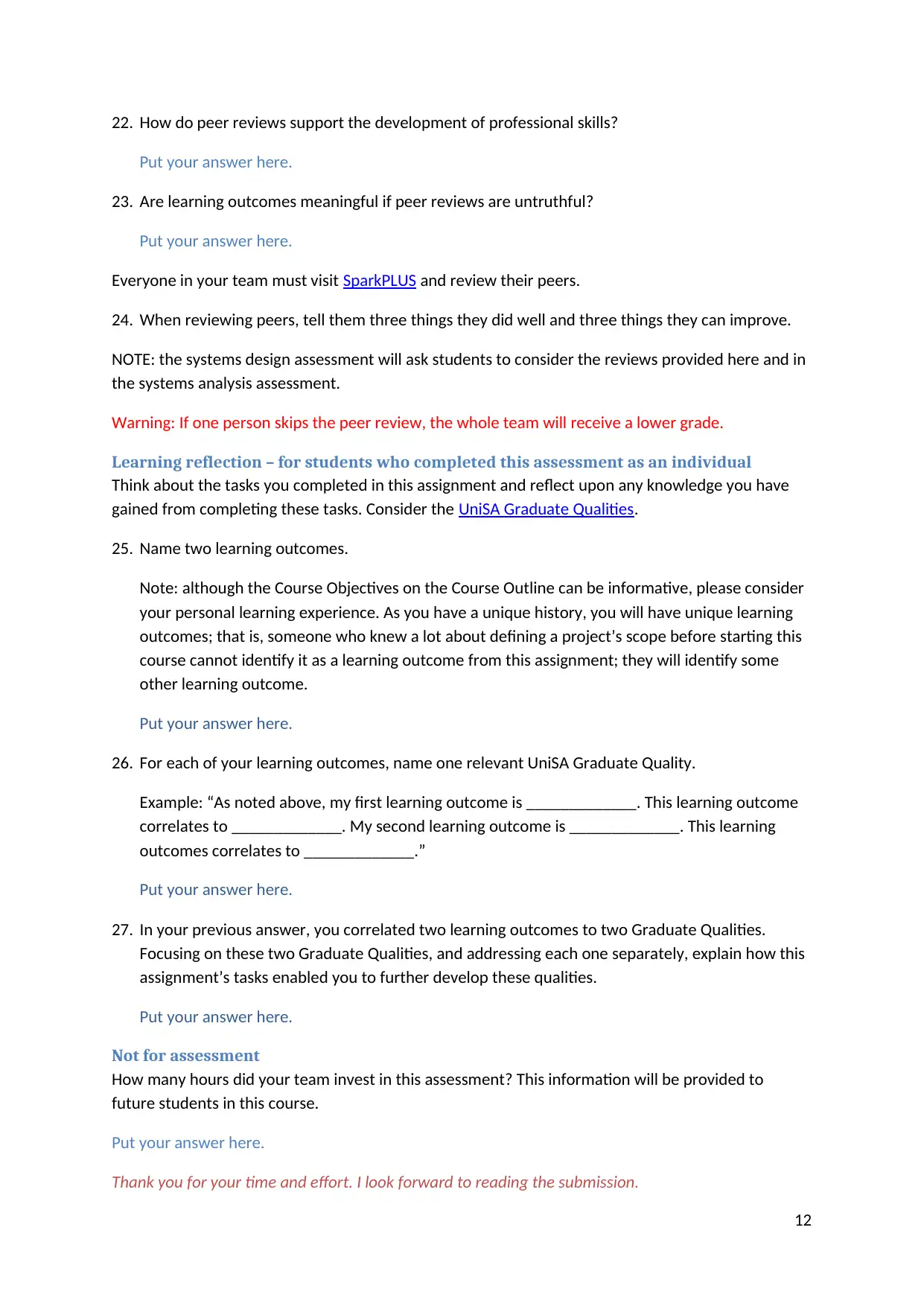
22. How do peer reviews support the development of professional skills?
Put your answer here.
23. Are learning outcomes meaningful if peer reviews are untruthful?
Put your answer here.
Everyone in your team must visit SparkPLUS and review their peers.
24. When reviewing peers, tell them three things they did well and three things they can improve.
NOTE: the systems design assessment will ask students to consider the reviews provided here and in
the systems analysis assessment.
Warning: If one person skips the peer review, the whole team will receive a lower grade.
Learning reflection – for students who completed this assessment as an individual
Think about the tasks you completed in this assignment and reflect upon any knowledge you have
gained from completing these tasks. Consider the UniSA Graduate Qualities.
25. Name two learning outcomes.
Note: although the Course Objectives on the Course Outline can be informative, please consider
your personal learning experience. As you have a unique history, you will have unique learning
outcomes; that is, someone who knew a lot about defining a project’s scope before starting this
course cannot identify it as a learning outcome from this assignment; they will identify some
other learning outcome.
Put your answer here.
26. For each of your learning outcomes, name one relevant UniSA Graduate Quality.
Example: “As noted above, my first learning outcome is _____________. This learning outcome
correlates to _____________. My second learning outcome is _____________. This learning
outcomes correlates to _____________.”
Put your answer here.
27. In your previous answer, you correlated two learning outcomes to two Graduate Qualities.
Focusing on these two Graduate Qualities, and addressing each one separately, explain how this
assignment’s tasks enabled you to further develop these qualities.
Put your answer here.
Not for assessment
How many hours did your team invest in this assessment? This information will be provided to
future students in this course.
Put your answer here.
Thank you for your time and effort. I look forward to reading the submission.
12
Put your answer here.
23. Are learning outcomes meaningful if peer reviews are untruthful?
Put your answer here.
Everyone in your team must visit SparkPLUS and review their peers.
24. When reviewing peers, tell them three things they did well and three things they can improve.
NOTE: the systems design assessment will ask students to consider the reviews provided here and in
the systems analysis assessment.
Warning: If one person skips the peer review, the whole team will receive a lower grade.
Learning reflection – for students who completed this assessment as an individual
Think about the tasks you completed in this assignment and reflect upon any knowledge you have
gained from completing these tasks. Consider the UniSA Graduate Qualities.
25. Name two learning outcomes.
Note: although the Course Objectives on the Course Outline can be informative, please consider
your personal learning experience. As you have a unique history, you will have unique learning
outcomes; that is, someone who knew a lot about defining a project’s scope before starting this
course cannot identify it as a learning outcome from this assignment; they will identify some
other learning outcome.
Put your answer here.
26. For each of your learning outcomes, name one relevant UniSA Graduate Quality.
Example: “As noted above, my first learning outcome is _____________. This learning outcome
correlates to _____________. My second learning outcome is _____________. This learning
outcomes correlates to _____________.”
Put your answer here.
27. In your previous answer, you correlated two learning outcomes to two Graduate Qualities.
Focusing on these two Graduate Qualities, and addressing each one separately, explain how this
assignment’s tasks enabled you to further develop these qualities.
Put your answer here.
Not for assessment
How many hours did your team invest in this assessment? This information will be provided to
future students in this course.
Put your answer here.
Thank you for your time and effort. I look forward to reading the submission.
12
⊘ This is a preview!⊘
Do you want full access?
Subscribe today to unlock all pages.

Trusted by 1+ million students worldwide
1 out of 13
Related Documents
Your All-in-One AI-Powered Toolkit for Academic Success.
+13062052269
info@desklib.com
Available 24*7 on WhatsApp / Email
![[object Object]](/_next/static/media/star-bottom.7253800d.svg)
Unlock your academic potential
Copyright © 2020–2025 A2Z Services. All Rights Reserved. Developed and managed by ZUCOL.


